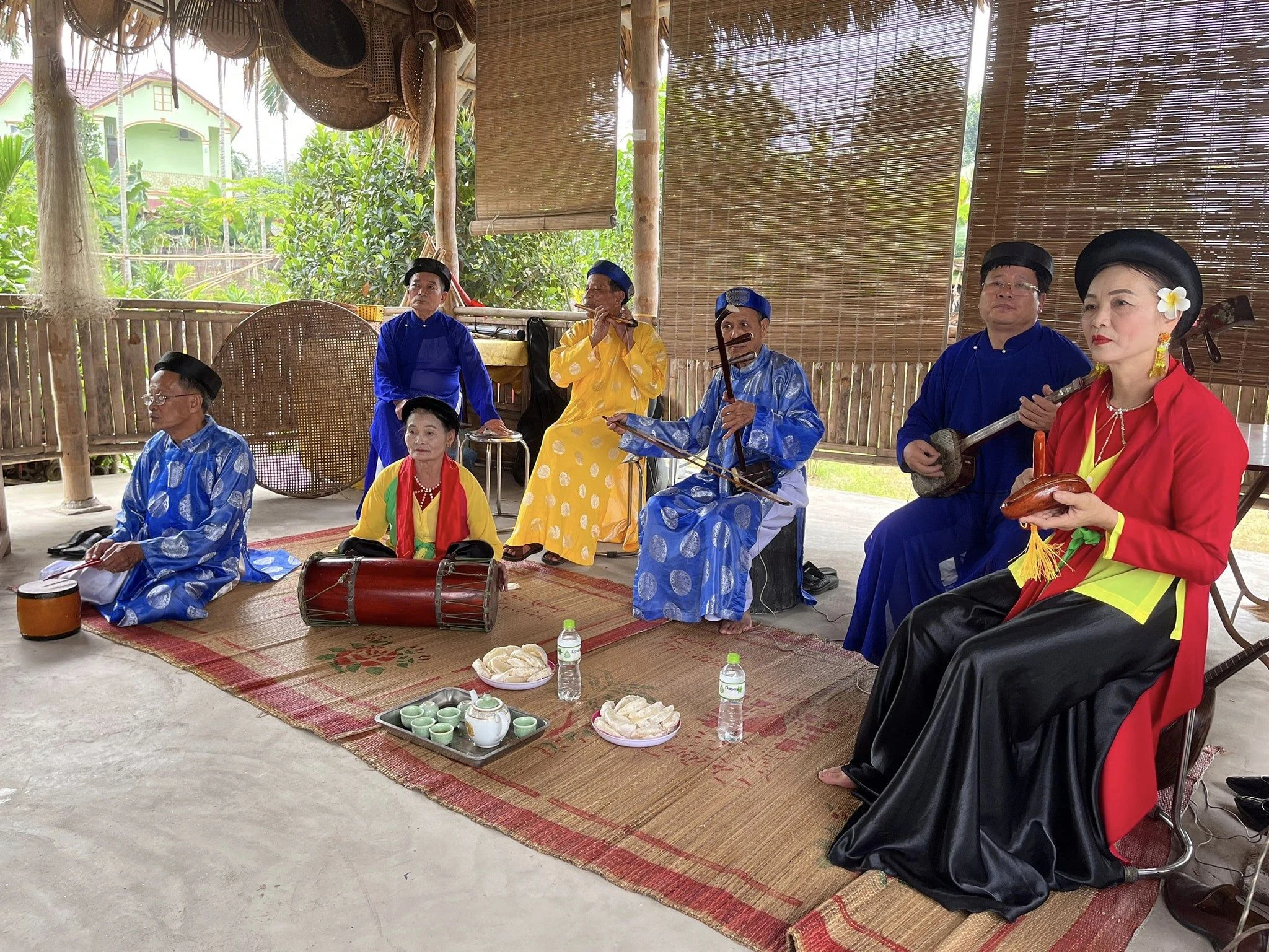{title}
{publish}
{head}
Cheo singing has long been deeply rooted in the culture of the Ancestral Land, serving as a vital cultural element for many villages in the midlands. It is not only performed during festivals but also resonates in daily life through the heartfelt performances of local artists, adding vibrancy and rhythm to the community.
Cheo is a unique fusion of folk songs, dances, and music originating in the Northern Delta of Vietnam. It conveys stories through theatrical performances, with the stage and actors serving as the bridge between the art and its audience. Cheo is often performed impromptu, with artists singing on mats spread out in communal houses and pagodas, which serve as venues for communal religious activities—hence the name "Cheo mats."

Cheo singing practice session of members of the Xoan and Cheo singing clubs in Minh Coi commune, Ha Hoa district.
Before the August Revolution (1945), Cheo melodies in Phu Tho were commonly performed at village festivals and formal gatherings in communal houses. People practiced Cheo in a “self-composing and self-performing” manner. After the country’s liberation, this traditional art form continued to be preserved in certain localities within the province.
Over the past decade, the Xoan and Cheo singing club of Minh Coi Commune, Ha Hoa District, has actively engaged in cultural exchanges and performances during festivals, Tet celebrations, and other communal events. In addition to these performances, members regularly practice by refining old songs for fluency and learning new ones. Rehearsals take place in various settings—on mats spread in communal houses and pagoda courtyards or at club members' homes. The members enthusiastically immerse themselves in Cheo melodies, playing traditional instruments like drums and fiddles in harmony. Over time, Cheo mats have become an integral part of life in Minh Coi Village, helping to preserve the homeland’s traditional art, foster a stronger sense of community, and add warmth and poetic charm to daily life.
Ms. Nguyen Thi Hoa Lan, Vice President of the Club, shared, "Our club was founded many years ago but fell into neglect for a period. It was only restored in 2014 and has since resumed stable operations. Currently, we have 44 members, with about 25 actively participating in regular activities, while the rest, mostly elderly members, serve as advisors.
The club operates on a voluntary and self-funded basis, supporting itself through the purchase of musical instruments, props, and costumes. It performs at events that serve the commune’s cultural and political activities and participates in district and provincial competitions, particularly during the annual Au Co Temple Festival.
Beyond Ha Hoa, Cheo is also being preserved and practiced in several communes across districts such as Tam Nong, Lam Thao, Thanh Thuy, and Viet Tri City. Those engaged in Cheo singing come from all walks of life—farmers, freelance laborers, civil servants, and retired officials. They come together to sustain, pass down, and showcase this traditional art within the community.
According to the Department of Culture, Sports, and Tourism, 11 individuals in the province currently teach Cheo regularly within the community, while 65 others are actively involved in practice. Together, they are preserving around 20 traditional melodies.
Although not as widely practiced as Hat Xoan, Hat Cheo remains a deep cultural foundation that shapes the spirit of many villages. Through life’s many ups and downs, Cheo melodies have served as a source of comfort, nurturing the pure and simple souls and strengthening their faith in life.

The Cheo singing team of Thanh Thuy District performs at La Phu Communal House in Thanh Thuy Town, showcasing the richness of this traditional art form.
However, this art form faces many challenges, particularly in passing it down to the next generation to ensure its preservation and growth. With a limited number of practitioners, mostly elderly and middle-aged individuals, the art is transmitted orally, with students imitating their teachers. The same applies to instrumentalists, who learn by observing and following others. Only a few localities have full folk orchestras to accompany Cheo performances. At present, only Ha Hoa and Thanh Thuy districts have trained musicians. The available instruments are sufficient for maintaining performances, which include drums, flutes, the two-stringed fiddle, wooden fish, three-stringed and four-stringed fiddles, and the monochord. The remaining districts of Tam Nong, Lam Thao, and Viet Tri City rely on pre-recorded music from the internet for their performances. Participants in Cheo art activities also face financial difficulties, as the clubs operate on a voluntary and self-funded basis, relying on self-funding to purchase musical instruments, props, and costumes.
Recently, the Ministry of Culture, Sports, and Tourism has submitted “Cheo Art” to UNESCO for consideration as an intangible cultural heritage, covering the provinces of Phu Tho, Thai Binh, Ninh Binh, Ha Nam, Nam Dinh, Hai Duong, Hung Yen, Bac Ninh, Vinh Phuc, Quang Ninh, Bac Giang, Thai Nguyen, Hanoi, and Hai Phong. This not only highlights the unique cultural values of Cheo but also recognizes the dedication of the people of Phu Tho in preserving and promoting this traditional art form.
To ensure that Cheo continues to thrive in modern society, greater support is needed from all levels of government and society. This will help practitioners feel secure in their dedication while keeping Cheo melodies alive in the hearts of the people of the Ancestral Land.
Thu Huong

In recent years, the Department of Culture, Sports and Tourism of Phu Tho Province has paid close attention to the conservation and promotion of cultural heritage values.

baophutho.vn For the Muong people in Hoa Binh, gongs are not only musical instruments, but also a “sacred soul treasure” accompanying them from birth until...

baophutho.vn The Ministry of Culture, Sports and Tourism has officially announced the updated List of National Intangible Cultural Heritages. Following the...

baophutho.vn Set against the rich cultural backdrop of the mountains and forests, the cuisine of the Muong ethnic group has become an essential element in...

baophutho.vn On the morning of July 30, at Thuong Temple on Nghia Linh mountain within the Hung King Temple Historical Site, a delegation from the...

baophutho.vn Following the reorganization of commune-level administrative units, the Muong Vang region, formerly part of Lac Son district, was restructured...

baophutho.vn On the quiet Hill 79 in Hoa Binh Ward, nestled in the heart of the city along the Da River, lies a memory zone that quietly preserves the...

baophutho.vn The traditional art of creating skirt patterns among the Muong people, originally in Hoa Binh province, now part of Phu Tho province, has been...

baophutho.vn The Ministry of Culture, Sports, and Tourism has officially released the latest List of National Intangible Cultural Heritages, with the newly...

baophutho.vn The project to merge the three provinces of Phu Tho, Vinh Phuc, and Hoa Binh into a new Phu Tho province places high demands on solidarity and...

baophutho.vn For generations, the custom of “buying salt at the beginning of the year, buying lime at the end of the year” has been a cherished cultural...

baophutho.vn Hung Lo ancient village, Hung Lo commune, Viet Tri City, has long been famous for its many delicious, unique dishes that anyone who has tasted...